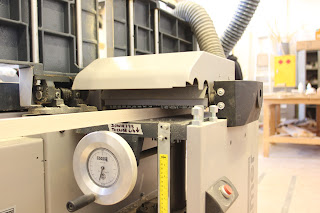BUT, before I left Cardiff I managed to get the majority of the routing done.
It was very much trial and error to start with but I think I've got the hang of it now.
Firstly, plane off the bottom of your newly laminated cores. It is important to do this first so there is a good machined edge to work off.
It took a lot longer than I thought as you can't take off more than 1-2 mm at a time. I found its probably best to start at the tips as this is where the majority of the material needs to be removed. To start with the router cradle wasn't touching the jig because there was too much material there but after a few passes I started to see the profile I wanted.
These photos are from the first ski I did where I started in the middle and worked outwards and as you can see I've ended up with a big lip on the end. This will need to be removed but could have been avoided by starting from the outside and working down.
When you're finished your ski base should be nicely smooth and even. It should feel like its been sanded. To achieve this it's best if you do long steady passes over the length of the ski instead of a side to side motion.
The next step is sourcing base materials and making a pressing jig. I'm still looking for a company to make this with a CNC machine but it can be done by hand (it's just less accurate).
Hope everyone is well.
GF










